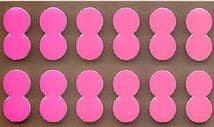This post was last updated on January 27th, 2022 at 09:06 pm
Fly fishing is a sport that can be enjoyed by anyone, and fly fishing indicators help with that. It’s not about how big your muscles are, or how fast you can run; it’s about patience and technique. Fly fishing indicators help identify strikes and keep your line from tangling during the fight with a fish. These devices come in many different shapes and sizes, but all of them serve the same purpose: to make fly fishing easier for beginners as well as experts. But there are some things to know before you go out on the water—things like what kind of indicator to use, how they work, and more!
Let this article walk you through everything fly fishermen need to know about these important tools.
What is a Fly Fishing Indicator?
A fly fishing indicator is typically a small, split shot sinker with an arbor knot tied on the line. The weight of the shot helps keep your line suspended, and also adds weight to help you cast further. When you get ready to cast your line again, simply slide the knot up until it’s just below the water’s surface. If you have a high quality fly fishing indicator, this should be easy to do.
Varieties of Strike Indicators For Fly Fishing
You could call them floats, indies, indicators or whatever you want, but definitely don’t call them bobbers! :) Even though they are basically bobbers.. There are a lot of varieties on the market including some fairly new ones that have become the standard for most nymphing. Here I will go over the many styles and talk a little about what each type of fly fishing strike indicators are best for certain situations.
The Thingamabobber
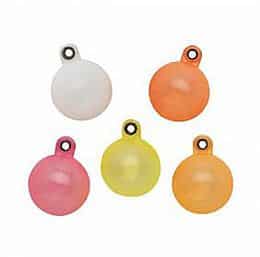 These are a recent addition to the many types of indicators available. They hit the market in 2006 or 2007 if I am not mistaken. They are a great way to detect strikes and come in many different sizes. I have used them for everything from drifting streamers and heavy girdle bug flies, to small size 20 midges. They are very lightweight for the amount of weight they can hold, and cast very nicely. These are my usual go to indicator when I decide to turn to
These are a recent addition to the many types of indicators available. They hit the market in 2006 or 2007 if I am not mistaken. They are a great way to detect strikes and come in many different sizes. I have used them for everything from drifting streamers and heavy girdle bug flies, to small size 20 midges. They are very lightweight for the amount of weight they can hold, and cast very nicely. These are my usual go to indicator when I decide to turn to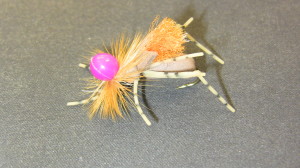 nymphing.
nymphing.
Thingamabobber also makes some other floating accessories, such as thingamabodies and really small indicators that can be used as a floating parachute on your flies. Notice the pink thingamabobber on the hopper pattern right. These will keep your fly floating in any condition. I have found that they will twist up your line a little bit used in this manner, however this isn’t too big of a deal if you don’t let the twisting get out of hand. They are also very effective for the hopper dropper rigging method shown here.
The Thingamabody
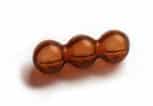 These are interesting little floating bodies used for tying flies. They have 3 sections and make great chernobyl ant bodies and work well for salmon flies and hoppers as well.
These are interesting little floating bodies used for tying flies. They have 3 sections and make great chernobyl ant bodies and work well for salmon flies and hoppers as well.
Various Foam Fly Fishing Indicators
Many versions of foam indicators exist, lets have a look at them..
Pinch on Foam Indicators
These simple pinch on indicators have been around for a long time. They work pretty good for small nymphs and that weigh very little. They are not terribly aerodynamic, but they sure are light. These are not reusable, so that is clearly a downside. They are quite cheap however (at around $3.00 for 24) they will do the job for the light weight occasional nymph fisherman. A pack of these takes up little space, so every light weight nymph fisherman should keep a pack of these strike indicators in the pocket of their vests, just in case..
Foam and Poly V Style Indicators
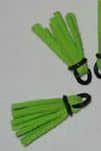
 These are very sensitive indicators, they will easily detect some very light strikes from fish. They seem to have a lot of wind resistance when casting, so fishing these in heavy wind would not be the best choice. You would be better off opting for a much heavier indicator during high winds.
These are very sensitive indicators, they will easily detect some very light strikes from fish. They seem to have a lot of wind resistance when casting, so fishing these in heavy wind would not be the best choice. You would be better off opting for a much heavier indicator during high winds.
Foam Fly Fishing Indicators with Slots and Rubber Core
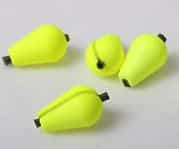
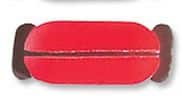 These are versatile indicators that will cast very well in high winds, because of their shape and density.
These are versatile indicators that will cast very well in high winds, because of their shape and density.
They have no trouble floating some fairly large flies as well. They don’t float flies as well as the thingamabobbers (above) but they cast better on gusty days. They attach in a couple of different ways. Some models shown here have a rubber core that you twist your line around to keep them sturdily in place, while others use tooth pick like pieces of wood or plastic rods. I have become quite fond of the rubber core style due to ease of use.
I really appreciate the slogan of these fish pimp indicators (right)” every nymph needs a pimp”. That’s catchy, and these indies work well. They also come in a convenient little tube for easy storage and dispensing.
How to Rig a Strike Indicator for Fly Fishing
Well, strike indicators work best when dead drifting streamers or nymphs through rubble bottoms. They will work great for this if you rig them just under the indicator and have a nice heavy weight on your fly line to get them down where they need to be.
Where to Place a Strike Indicator on a Fly Line
The best way to fish a strike indicator with nymphs or streamers is by placing it one or two feet up from the end of your tippet. This means that you need to attach them on either your fly line or leader about fifteen feet above your level tippet. The reason for this placement is simple, you need to get the fly down near the bottom. The closer you are to the bottom, the more likely you are to get bit by a trout that’s looking up at your fly.
Do I Need a Strike Indicator to Fish a Nymph?
No, you don’t need a strike indicator to fish a nymph. You can just tie the level tippet off to an overhand knot or nail knot in the end of your fly line and fish the nymph dead drift. This is not really effective though for two reasons, first it’s quite difficult to get your depth right when you do it like this and second you will lose a lot of flies in the rocks when fishing heavily fished water.
Key Takeaways – Fly Fishing Indicators
A fly fishing indicator is a device that helps to detect the strike of fish. The foam style indicators are for lighter weight flies, while heavier ones can be used in windy conditions or when large flies need to be cast. There are many different styles and colors available which will suit various preferences. Some fly fishermen find it helpful to rig their indicator directly under the tippet so they know exactly where trout may take the fly, especially if there is no current providing an easy visual cue as to depth at any given moment.
Hopefully this article answers all your questions about fly fishing indicators!

